Hello Fellow ChartWatchers!
One of the things we are always trying to do here at StockCharts is "improve." We are always trying to make the website better - faster, more powerful, more flexible, you name it. We are also always trying to increase its value. Today, I'm thrilled to announce two big changes that are happening which will GREATLY increase the value of a StockCharts membership.
(For all you skeptics out there, the price hasn't changed at all. I'm announcing new features and improvements for the exact same price as before.)
FOR ALL OF THE EXTRA AND EXTRA-RT MEMBERS OUT THERE:
Many of you have been asking for more space to store large numbers of ChartLists. Evidently, as people find more ways to categorize charts, they have outgrown our old limit of 100 ChartLists per account. Many people have asked us for more space and now, we're happy to give it to them:
EFFECTIVE IMMEDIATELY, ALL EXTRA AND EXTRA-RT MEMBERS CAN NOW STORE UP TO 200 DIFFERENT CHARTLISTS IN THEIR ACCOUNTS!
Each list still holds up to 500 charts so that is double the space you used to have. This feature is already enabled and waiting for you to take advantage of it. Just login to your account and click the "Add a New List" link on the Members page. We can't wait to see what you do with twice as much space as you had before. Enjoy!
But wait, there's more!
Check out the "Site News" article below for more information about additional improvements we've made just for Extra members including my favorite - "Near Real-time Scanning!"
BUT WAIT, I'M A "BASIC" SUBSCRIBER. WHAT ABOUT ME?
We're saving the best for Basic members. In about a week, we're going to be upgrading our Basic accounts significantly. Instead of only being able to store 100 non-annotated charts, soon Basic members will be able to store 500 charts AND those charts can be annotated. In addition, Basic members will have access to all of the different "Views" that Extra members now have - including the MarketCarpet view, the CandleGlance view, and the Summary view. Basic members will also be getting access ChartStyles, StyleButtons and much more.
In short, a Basic account will soon be identical to an Extra account except that a Basic account will only have a single ChartList.
(Again, these Basic improvements aren't available quite yet. They will be rolled out in the next week or so. Watch the "What's New" area for details.)
Now, that might sound like a lot improvements, but I'm just getting started. Look for the announcement of another huge improvement that will give you even more value for the same cost in our next newsletter. And then, in the first newsletter in December, I'll be announcing StockCharts.com's biggest surprise to date - something that I'm extremely excited about and can't wait to share with everyone. Stay tuned!
- Chip
The ability of any stock index or group to clear its April high is a sure sign of strength. In case you haven't noticed, the Semiconductor Holders are doing just that today. I point that out because, up until a couple of months ago, chip stocks were market laggards. Chart 1, however, shows that's no longer the case. Not only is the SMH clearing its April, high, but the SMH/SPX ratio (below chart) has been rising since early September. A number of individual stocks in the group have hit new 52-week highs including (in order of size) Texas Instruments (TXN), Analog-Devices (ADI), Altera (ALTR), Linear Technology (LLTC), Broadcom (BRCM), KLA-Tencor (KLAC), and Novellus (NVLS). One of the biggest chip stocks (which is often viewed as a group bellwether) is Intel which has been a group laggard. But it too is is starting to look a lot stronger. Chart 2 shows Intel trading at a new three-month high after clearing a six-month down trendline and its 200-day moving average. The strong upturn in semiconductors also carries good news for the broader market since it's a big part of the technology sector. And the market is usually stronger when the technology sector (and the Nasdaq) are leading it higher. Another heavily weighted chip stock, Applied Materials, has also just cleared its 200-day line (Chart 3).
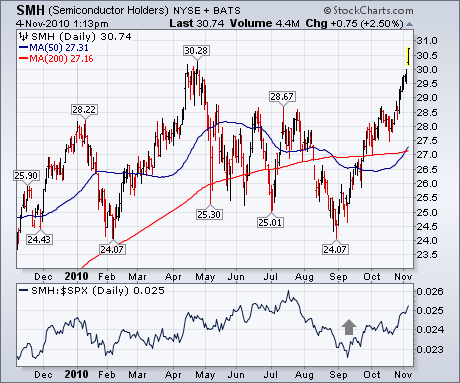
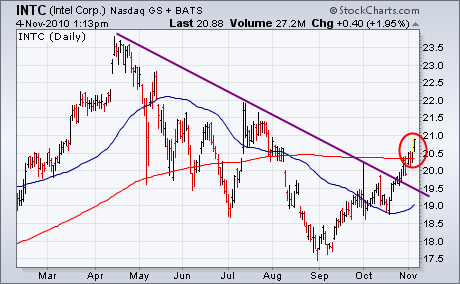
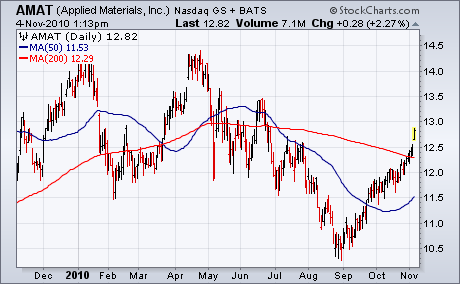
Although a little late to the party, the Nikkei 225 ($NIKK) is showing signs of life with an inverse head-and-shoulders pattern taking shape. Note that the S&P 500 formed an inverse head-and-shoulders from mid May to mid September and broke resistance in the second half of September. The Nikkei continued to a new low in late August, but forged a higher low in early November to form the right shoulder. The chart below shows the left shoulder forming in July and the head in late August. With the global rally in stocks, the Nikkei surged to neckline resistance with a strong move the last two days. This reversal pattern would be confirmed with a neckline break, but I am marking a resistance zone around 9750 based on the neckline and October high. A break above the October high would complete the pattern. According to classic technical analysis, the distance from the neckline to the August low (head) is added to the breakout for a target. This targets a move to around 10650.
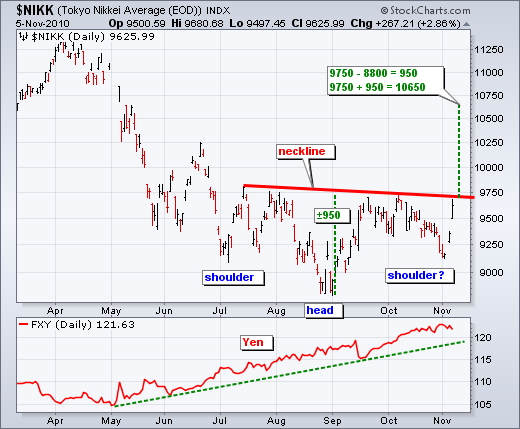
Click this image for a live chart
(This is an excerpt from Friday's blog for Decision Point subscribers.)
As of 7/14/2010 the US Dollar has been on a Trend Model NEUTRAL signal, and it has been in a bear market since the end of September when the 50-EMA crossed down through the 200-EMA. On the daily chart below you can see that the index has been in a declining trend channel since the June top. When it hit the bottom of the channel in October, I thought it might bounce back up to the top of the channel, but QE2 killed that idea.
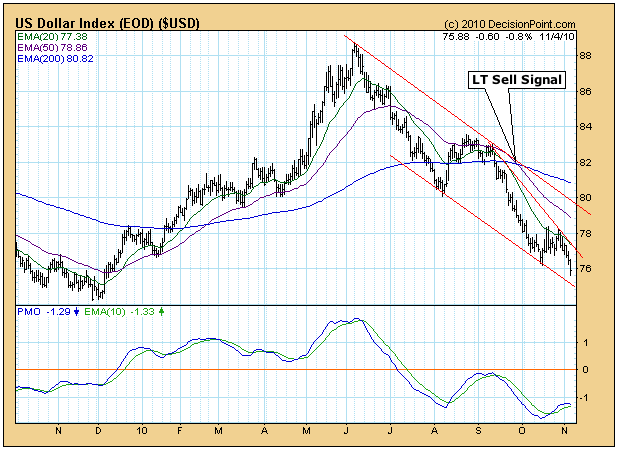
While the index remains above the bottom of the channel, the decline of the last two days has longer-term implications which are easy to see when we zoom back with a view of the weekly chart. The rising trend line drawn from the 2008 lows has been violated. Before we can say that the breakdown is decisive (unlikely to be reversed) the index would have to drop to about 74, but the fact that the most recent top formed well below the primary declining tops line tells me that the decline is accelerating.
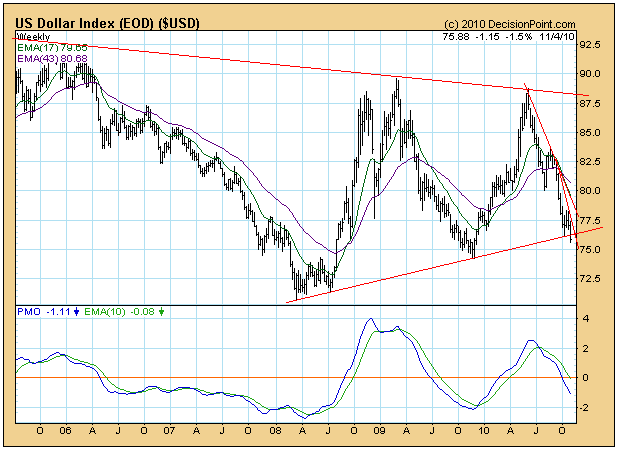
Finally, we zoom farther back using a monthly chart. You can see the line drawn down from the 2002 top (flag pole) with the triangle (pennant) attached to the bottom of it. I think this looks like a giant reverse pennant formation, and the implications are extremely bearish -- a downside projection of about 50 points. To me that sounds crazy, but so does what the Fed is doing.
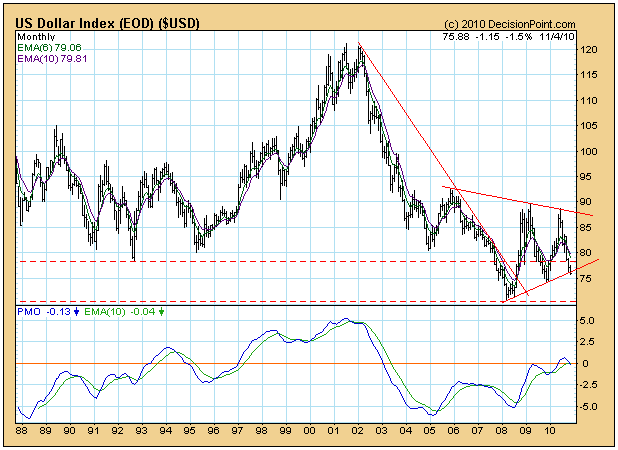
Bottom Line: Our mechanical Trend Model has us in a neutral stance on the dollar, but the charts are bearish. There is a slight chance that the breakdown from the long-term rising trend line could be reversed, but there is certainly no fundamental reason why this should happen. The Fed is determined to devalue the dollar, and I think, based on the technicals, that they will succeed beyond their wildest dreams.
It's been a breathtaking move. The NASDAQ was trading near the 2100 level at the end of August. Friday it closed at 2579. That's more than a 25% move in just over two months. Of course that followed a 17% decline from April through August. The bottom line is this: The NASDAQ is approximately 2% higher than it was at the April high. The Dow Jones is also roughly 2% higher since April. The S&P 500 and Russell 2000 are closer to breakeven.
Here is the good news - the financials broke above key resistance as the Dow Jones US Financial Index ($DJUSFN) finally broke above that 271 level. Right on cue, financials led on a relative basis last week and pulled the major indices higher with it. That 271 level now becomes excellent support. Until the bears can tear down support on the financials at that level, you've got to be long the group. We saw what happened to semiconductors when resistance was initially cleared. They exploded and so did the NASDAQ and NASDAQ 100. Now it's the financials' turn. We're not sure that the major indices will fly from current levels, but we do expect dollars that rotate out of other sectors to find a home in financials. That should spell solid outperformance in the near-term, at a minimum.
Check out the chart below:
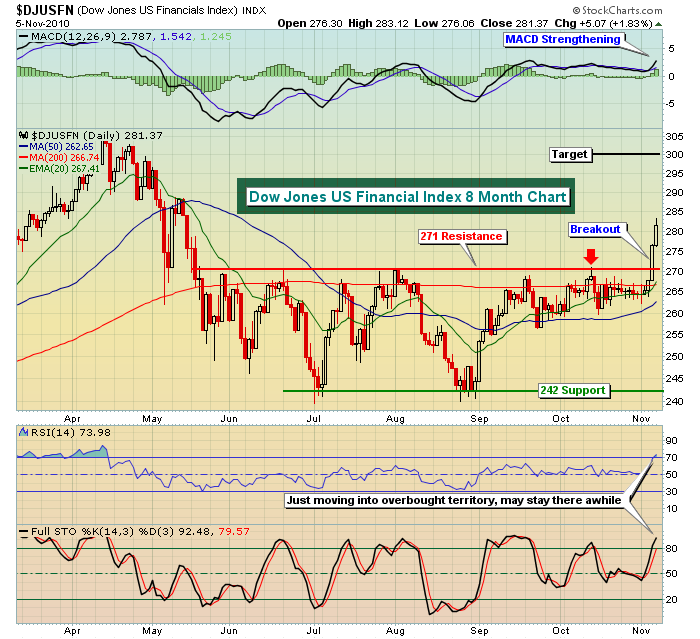
Financials were stuck in a 242-271 trading range. The breakout measures initially to 300 and we wouldn't be surprised to see the group rise in the short-term to that level. The new trading range is 271-300. Based on this range, the current reward to risk is nearly 2 to 1. We like the odds of being long this group, especially on any pullback near 271.
Ok, that's the good news. The bad news is that folks are actually beginning to believe in this rally. Complacency can derail a bull run and we're showing early signs of exactly that. I measure complacency using the relationship between equity calls and equity puts traded. The psychological state of the retail trader can be seen by this ratio and by the contract volume. Complacency was highly prevalent in April and was one of several reasons why I believed the market was topping. Recently, as the market was approaching key resistance levels, I commented to members that the resistance was more likely to be taken out due to the lack of complacency. In other words, there was little belief by the retail trader that the market could go higher. That non-committal to call options was at least one reason why the market did break out. But now the optimism is building. My focus on the equity only put call ratio (EOPCR) is the subject of Monday's Chart of the Day. CLICK HERE to view the annotated chart and to listen to the video version.
There have been many technicicans who've felt the market was too overbought to continue moving higher over these past few weeks. The current RSI and stochastics readings on the S&P 500 are at 79 and 99, respectively. That's EXTREME overbought territory and means the market has to move lower, right? Not necessarily. RSI and stochastics serve very useful purposes, but identifying the type of market is the first step in determining how much to rely on RSI and stochastics. Overbought can remain overbought for long periods of time. It varies depending on the market. Our next Online Trader Series event, scheduled for this Thursday at 4:30pm EST, will feature the best ways to utilize RSI and stochastics in your trading strategy. I'll be happy to show you when you can least rely on these two momentum indicators. CLICK HERE for more information on this event.
Happy trading!
With the "troika" of the US mid-term elections, FOMC meeting decision on QE-2, and the US Employment Situation Report having been digested by the markets, we thought it instructive to step back and take a longer-term viewpoint of the NASDAQ Composite. Perhaps by looking at the Composite, we can infer whether or not QE-2 will be successful in terms of raising asset prices in the coming year or years. Certainly the Composite has been a relative laggard since the bubble days of 1998-to-2000, that is until the past year. Thus, it piques our long-term interest, and perhaps more importantly...it will clear and discernible impact our trading strategy.
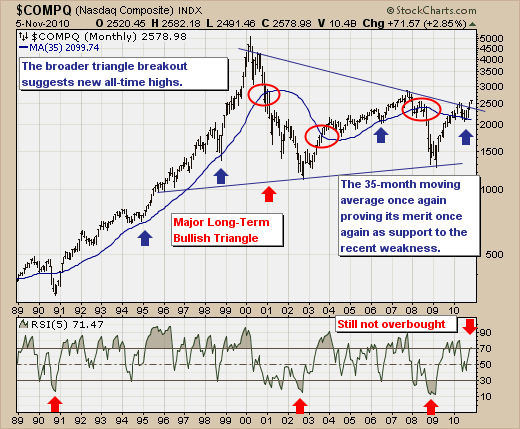
Turning to the monthly chart, we find the multi-year bullish triangle of which trendline resistance is clearly being given - which would argue for new highs years down the road. Certainly recent dour economic prognostications related to money printing et al should be the type of environment in which this should occur. But the fact of the matter is that support levels are holding, while resistance levels are being violated - the hallmark of a bull market. Moreover, the probability for prices extending their gains is rather good the 35-month moving average support level has time and time again over the course of 4-months held up admirably to assault. We are rather impressed by this; and our readers should be too.
Therefore, as long as the 35-month moving average provides support - then one must consider using sharp corrections upon which to accumulate technology shares. Once it does fail, then we'll be inclined to be aggressively short...but not until then. The final fact of the matter is that QE-2 may have some very real long-term unintended consequences - meaning very sharply higher asset prices or "bubbles" once again. And who doesn't like sharply higher asset prices? So...here's three cheers to the "good ole' days" of the 1998-to-2000 NASDAQ rally!